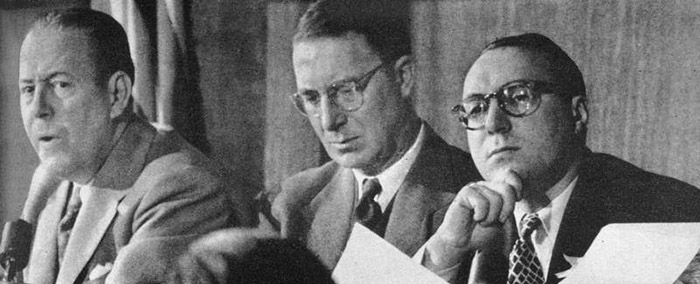
Imagine a TV show more popular than the Super Bowl and more riveting than any top rated crime drama—that was the Kefauver Committee Hearings (committee). In 1950, a Senate investigative committee led by Senator Estes Kefauver was commissioned to investigate organized crime in interstate commerce. As the committee explained in their first interim report they came into being because "a considerable segment of the thinking population of the country had come to the inescapable conclusion that organized crime had developed into a serious national problem."
But there was tension underpinning the committee's work. This opinion that organized crime was a national menace desiring federal attention was not held by all, but in particular by J Edgar Hoover. Hoover publicly expressed doubts of the existence of national crime syndicates that met regularly to coordinate illicit activity and carve out territories. Hoover's law enforcement contemporary, Harry Anslinger, the head of the Bureau of Narcotics, had a diametrically opposed view. It was Anslinger that made it his life's calling to collect detailed intelligence on the crime families. He introduced the country to the term "mafia" and vocally warned America that the drug trade would soon be organized crime's top income stream. Both men testified before the committee.
The Kefauver hearings were held in 14 large American cities. At the time, only half of the American households had television sets yet an estimated 30 million Americans tuned in. And if they could not watch it at home, they could simply go to the local bar, restaurant and even movie theater to view the hearings. Below is an excerpt from the United States Senate web page that details the event:
"The Kefauver committee hearings became the most widely-viewed congressional investigation to date. The broadcasts made the Kefauver committee a household name. Schools dismissed students to watch the hearings. Housewives neglected housework. Blood banks ran low on donations, prompting one Brooklyn center to install a television and tune in to the hearings and donations shot up 100 percent."
According to Life magazine, "Never before had the attention of the nation been riveted so completely on a single matter. The Senate investigation concluded that it "was almost the sole subject of national conversation."
The obvious public draw was the parade of kingpin mobsters subpoenaed to testify before the cameras. It was a who's who of the nation's most infamous racketeers. Some of the A-list mobsters included Tony Accardo, Mickey Cohen, Frank Costello, Meyer Lansky and Abner Zwillman. There was also a sea of local government officials including police chiefs and sheriffs that were believed to have facilitated and protected the gangsters' operations.
Several subpoenaed individuals thought a well-deserved foreign vacation was more in order. According to TIME magazine, "Many of Big Crimes big men have paid Kefauver the compliment of disappearing." But there were plenty that did appear to make it a mesmerizing media event. The drama unfolded according to TIME, "as a motley crew of mobsters admitted what they could not deny, chanted insolently when cornered, I don't remember."
What America learned from the hearings was that the repeal of the Volstead Act (Prohibition) by no means was the death knell that many had predicted. The virulent disease of organized crime simply mutated and found new hosts. As TIME eloquently stated, "the U.S. fast buck boys had moved in on a bonanza which proved richer than their wildest dreams. The new bonanza: Big time gambling, organized on a big-time scale."
What the committee found most disturbing was "the extent of official corruption and connivance in facilitating and promoting organized crime." They discovered venal officials at the local, state and federal level willing to put their greed over their sworn duty, willing to look the other way, provide protection and even pass laws favorable to the mobsters. The reigning constant about organized crime in America and throughout the world is that it needs corruption to thrive.
In his book The Secret File, fame organize crime journalist Hank Messick commented that "the Kefauver Committee made the most penetrating probe ever conducted of the links between organized crime and politicians." And Messick had a strong opinion on what allowed them to accomplish this feat. "The investigation was successful largely because the President signed an executive order giving the committee the right to examine income tax returns and other information in the files of the IRS."
At the hearings, the committee endeavored to "Capone" those subpoenaed to testify. As TIME describes, "Armed with income-tax reports made available to them by President Truman himself, the committee grilled every sheriff and police executive they could find. It was not a pretty showing."
By law, tax return information cannot be disclosed. Even the FBI must obtain a court order to get federal tax information. But in a rare presidential order the committee not only was granted the personal tax returns of those subpoenaed to testify but also the tax returns of related partnerships and corporations. These business returns proved excessively biting in establishing connections because they revealed the names of the partners, corporate officers and major shareholders. Via tax return information, the committee was given a unique opportunity to connect the dots.
As the committee peered into the mobsters financial dealings, it became clear how sophisticated the crime bosses had become when laundering their ill-gotten gains and concealing their ownership interest. From a look back prospective we see that many of the current mainstay artifices and tricks commonly used today by money launderers were hatched and refined during this period.
Necessity breeds innovation. Bad guys only need to launder money to the extent that it will outwit those who might look into their financial affairs. Up to the 1920s, kingpin criminals faced little resistance flaunting their wealth and enjoying their assets. There really was no need to launder their ill-gotten gains. Law enforcement at the time had yet to harness the power of following the money to ensure crime does not pay.
But that all changed in the 1920s when a small band of ace financial investigators entered the crime fighting scene. They were known as the Internal Revenue Bureau's Intelligence Unit (IU), a law enforcement branch that was commissioned to use the criminal income tax statutes to combat tax evasion and bribery of Treasury officials.
Back then, among the biggest tax evaders were gangsters who enjoyed the rich opportunities Prohibition handed them on a silver platter. As bootleggers and racketeers basked in this dot.com-like era of crime, they were blindsided by the Intelligence Unit, who made their unexplained wealth an Achilles' heel. Their most famous conquest was Al Capone, who took an eleven year prison hit for tax evasion. But the Unit also took down many other legendary mobsters including Waxie Gorden, Johnny Torrio, Murray Humpreys, Leon Gleckman, Paul Ricca, Frank Nitti, Tom Pendergast and even Nucky Johnson from HBO's "Boardwalk Empire." The IU was slaying so many Goliath-like gangsters and corrupt politicians a federal judge nicknamed them "The Giant Killers."
In addition to borrowing from the IU's playbook, the Kefauver Committee called them into action to do what they did best. They requested the Internal Revenue Bureau initiate a Special Tax Fraud Drive to subject every known racketeer to a thorough tax investigation. A master list of nearly 30,000 names was compiled for this purpose. The director of the drive used the facilities of the Intelligence Unit in the National Office. Racket squads comprised of special agents, revenue agents and debt collectors were formed in offices throughout the country, and were placed under the overall direction of the Intelligence Unit's Special Agents in Charge.
And the racket squads were quite productive according to the Committee. "Formation of special racket squads has been reported on all levels, federal, state and local. The Bureau of Internal Revenue has swung into concentrated action with racket squads operating across the nation and reports of commendable progress in investigations of tax evasion by gangsters and racketeers have already been noted."
But it wasn't a walk in the park for the IU agents, also known as the T-Men. Gone were the days when gangsters were less attentive to money concealment matters. Syndicate crime leaders of the 1950s operated in the shadows. They cloaked themselves in a veneer of respectability by joining posh socialite clubs and donating to charity. They were not flashy and exercised far more restraint in publicly enjoying the fruits of their illicit activity. Wise mobsters learned from the unhappy mistakes of Capone and other kingpins. They also placed a far greater reliance on professionals to advise them on how to make their illicit activities financially invisible. Hence, we see in this period the burgeoning professional money laundering industry.
According to the testimony by assistant commissioner of Internal Revenue, Daniel A. Bolich, before the committee, "unlike the gangsters of the thirties, many of our modern big-time racketeers take deliberate and carefully contrived steps to defend themselves against the possibility of successful tax prosecutions. They frequently attempt to insulate themselves from direct attack by operating through a maze of corporations, dummy stockholders, and fronts." Bolich also testified that there exist professionals that specialize in preparing gangster returns. Bolich was a former Intelligence Unit Special Agent in Charge so he was experienced in these matters.
The committee alluded to the fact that "in many cases they (organized crime) have invested in legitimate businesses so that they could always point to these false fronts and claim that they were no longer engaged in crime in the event that a question might ever be raised as to their former criminal associations."
Faced with ramped up money laundering sophistication, the IU financial detectives had to refine their art of following the money. They became even more obsessed over the smallest of details to detect any signs that might point to a highly buffed financial trail. Agents focused on the nuances and developed epic perseverance.
An example of how focused the IU agent had become is exemplified by how a check for $5.10 brought down Frank Costello who, according to the Kefauver Committee, was one of the major syndicate leaders in America. Costello was financially well insulated and for years many had tried their hand at piercing the veil of his illicit wealth secrecy. Costello dealt in cash and seldom wrote a check. His public appearance before the Committee was one of the more high drama, notable performances. A snippet of it can be viewed on the U.S. Senate web site devoted to the Kefauver hearings.
Costello's downfall, brought on by a five-year sentence for tax evasion, started when IU Special Agent John Murphy identified a check for $5.10 signed by Costello's wife. The check was paid to a plant nursery that specialized in supplying cemeteries. On a hunch, Murphy followed the lead to a cemetery and confirmed that Costello purchased a lot for $4,888 in cash. Murphy took a look at the lot and noted it was occupied by an opulent marble mausoleum. He tracked down the contractor who received $18,615 in cash for the work. Buoyed by this successful foray, Murphy dug through bank microfilm and identified more checks written by the wife which led to more cash expenditures. Murphy's copious financial sleuthing led to further leads of hidden assets and debt payments. IU agents ultimately showed Costello failed to report a total of $384,824.
It was not just Costello that fell to the IU agents as they honed their financial sleuthing skills. The T-Men racked up an impressive list of alleged crime boss leaders originally profiled by the committee including Tony Accardo, Joe Adonis, Albert Anastasia, Pete Licovoli, Abraham Miker, Frank Wortman and Abner Zwillman.
One notable take down was Los Angeles crime boss Mickey Cohen, whose conviction on tax evasion was highlighted in the final Committee report. A bit of Hollywood trivia about Mickey: A recent major motion picture called "Gangster Squad" depicted the efforts of local law enforcement in attempting to bring Cohen to justice. The movie, however, did not highlight the fact that the only serious jail time Mickey ever got resulted from the skillful financial detectives of the IU. In fact, after he served five years for tax evasion Mickey was later convicted again on tax charges and sentenced to another 15 years.
In addition to the syndicate leaders, the IU brought to justice a slew of corrupt government officials who were lining their pockets by enabling the mobsters. This served as validation of the organized crime truism: It cannot metastasize without compromising public officials. The pathogen needs corruption to replicate.
The final committee report was issued in August of 1951. The committee had several takeaways from their work. First and foremost was a bold proclamation that "ORGANIZED CRIME DOES EXSIST." Peppering this pronouncement they stated "that the doubt which originally existed in the minds of many intelligent and careful persons as to whether crime is organized in the United States was in great measure deliberately planted there."
The committee also concurred with Anslinger's assessment that crime syndicates were infiltrating the drug trade. In their final report they detailed numerous recommendations on how to combat narcotic trafficking in America. They expressed grave concerns that drugs were being peddled to teenagers.
As it related to combating organized crime in general, interestingly, several of their recommendations dealt with attacking the problem from a financial angle. The committee recommended vigorously enforcing the Internal Revenue laws and requiring gambling establishments to maintain detailed books and records.
One suggestion, in particular, demonstrated how the Committee appreciated the challenges IU agents faced in following the money trail to its logical end. The committee suggested that, "The Internal Revenue laws and regulations should be amended so as to require any person who has been engaged in any illegitimate business netting in excess $2,500 a year for any of five previous years, to file a net-worth statement of all his assets, along with his income-tax returns."
When it came to big mobster bosses, IU agents often had no other investigative alternative than to reconstruct taxable income via a method that demonstrates indirectly the increase in net worth each year. This laborious court-accepted method of proof requires the establishment of a net worth starting point. And determining this starting point can be the most challenging aspect of this financial investigative technique. IU agents have to counter any defense that the target obtained his or her wealth prior to the period that can be statutorily recommended for prosecution.
Obviously, the gangster financial statement recommendation never came to fruition. But successful case work over the years from the men and women of the Intelligence Unit (now known as IRS Criminal Investigation) has continually shown the absence of such a requirement has not impeded or slowed them down.
The Kefauver hearings not only gave us a window into the evolution of money laundering but also a glimpse into how financial crime fighters hone their skills to match the sophistication of our nation's criminal elite. Can you imagine, though, the painful impediment the Bank Secrecy Act would have been if it was in place back then? The Kefauver hearings profoundly remind us of the value the ACAMS community provides America and the world in ferreting illicit activity.
Today, money laundering techniques continue to transmute and technology has exponentially enhanced this evolutionary process. No longer are money launders bound by logistics of brick and mortar financial establishments. Money can be transferred in a fraction of a second to any place in the world. And in the cyber world new forms of currency are being created that allow for much more anonymity.
Richard Weber, the current chief of IRS Criminal, knows very well the challenges his modern day financial sleuths face. He acknowledges that the world is entering an era that provides a multitude of digital methods of financial concealment, but he states, "IRS Criminal Investigation has a rich legacy of refining our unique skillset to stay ahead of money laundering wizards as they adapt to new technology." Chief Weber points to the indictment of Liberty Reserve, which is alleged to be a six billion dollar money laundering operation, all occurring in the digital realm and utilizing non-traditional forms of banking. According to Chief Weber, "Our work on this case proves we continue to sharpen our financial investigative marksmanship even in the age of cyber money laundering."
Chief Weber also recognizes the profound contributions of dedicated anti-money laundering professionals serving as critical sentries in the fight against major crime. "Their work enables us to ensure today's criminal elite still face a formidable foe that will relentlessly follow the money to ensure crime does not pay."
Paul Camacho, Special Agent in Charge for the Las Vegas Field Office of IRS Criminal Investigation, paul.camacho@ci.irs.gov
- From the redacted version of 75 YEARS OF CRIMINAL INVESTIGATION HISTORY
- From Hank Messick book, SECRET FILES. Also corroborated by Andrew Tully's TREASURY AGENT, the forward of which was written by Robert Anderson the Secretary of Treasury at the time of publication. These facts were publicly disclosed during trial.
- From the redacted version of 75 YEARS OF CRIMINAL INVESTIGATION HISTORY. The Zwillman trial resulted in a hung jury in 1956. In 1959 he committed suicide right before associates pled guilty to bribing the Zwillman jury.










